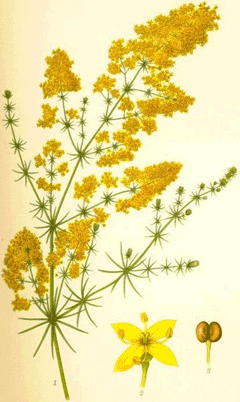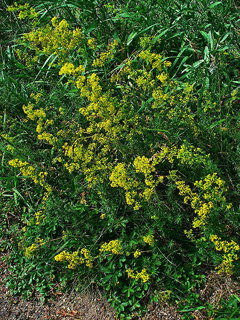 |
|
http://commons.wikimedia.org/wiki/File:Galium_verum_gulm%C3%A5ra.jpg |
 |
| http://commons.wikimedia.org/wiki/User:Llez |
Translate this page:
Summary
Physical Characteristics

 Galium verum is a PERENNIAL growing to 0.6 m (2ft) by 1 m (3ft 3in).
Galium verum is a PERENNIAL growing to 0.6 m (2ft) by 1 m (3ft 3in).
See above for USDA hardiness. It is hardy to UK zone 3 and is not frost tender. It is in flower from July to August, and the seeds ripen from August to September. The species is hermaphrodite (has both male and female organs) and is pollinated by Flies, beetles. The plant is self-fertile.
It is noted for attracting wildlife.
Suitable for: light (sandy), medium (loamy) and heavy (clay) soils and prefers well-drained soil. Suitable pH: mildly acid, neutral and basic (mildly alkaline) soils. It can grow in semi-shade (light woodland) or no shade. It prefers dry or moist soil. The plant can tolerate maritime exposure.
UK Hardiness Map
US Hardiness Map
Synonyms
Plant Habitats
Woodland Garden Sunny Edge; Dappled Shade; Meadow;
Edible Uses
Edible Parts: Leaves Seed
Edible Uses: Coffee Colouring Curdling agent Drink
Leaves - raw or cooked[62, 179]. A yellow dye from the flowering stems is used as a food colouring[105, 183]. The roasted seed is a coffee substitute[7]. The seed is also said to be edible[179]. The chopped up plant can be used as a rennet to coagulate plant milks[7, 67, 115, 183, 244]. The flowering tops are distilled in water to make a refreshing acid beverage[2, 183].
References More on Edible Uses
Medicinal Uses
Plants For A Future can not take any responsibility for any adverse effects from the use of plants. Always seek advice from a professional before using a plant medicinally.
Antispasmodic Astringent Diuretic Epilepsy Foot care Lithontripic Urinary Vulnerary
Lady's bedstraw has a long history of use as a herbal medicine, though it is little used in modern medicine. Its main application is as a diuretic and as a treatment for skin complaints[254]. The leaves, stems and flowering shoots are antispasmodic, astringent, diuretic, foot care, lithontripic and vulnerary[4, 7, 9]. The plant is used as a remedy in gravel, stone or urinary disorders[4, 9, 53, 238] and is believed to be a remedy for epilepsy[4, 21]. A powder made from the fresh plant is used to soothe reddened skin and reduce inflammation[7] whilst the plant is also used as a poultice on cuts, skin infections, slow-healing wounds etc[9]. The plant is harvested as it comes into flower and is dried for later use[9]. Both Asperuloside (a terpenoid) and Coumarin (a benzopyrone) occur in some species of Galium. Asperuloside can be converted into prostaglandins (hormone-like compounds that stimulate the uterus and affect blood vessels), making the genus of great interest to the pharmaceutical industry[238].
References More on Medicinal Uses
The Bookshop: Edible Plant Books
Our Latest books on Perennial Plants For Food Forests and Permaculture Gardens in paperback or digital formats.

Edible Tropical Plants
Food Forest Plants for Hotter Conditions: 250+ Plants For Tropical Food Forests & Permaculture Gardens.
More

Edible Temperate Plants
Plants for Your Food Forest: 500 Plants for Temperate Food Forests & Permaculture Gardens.
More

More Books
PFAF have eight books available in paperback and digital formats. Browse the shop for more information.
Shop Now
Other Uses
Dye Repellent Strewing Stuffing
A red dye is obtained from the root[4, 6, 7, 67, 115]. It is rather fiddly to utilize[169]. A yellow dye is obtained from the flowering tops[4, 7, 115]. The dye is obtained from the foliage when it is boiled with alum[207]. The dried plant has the scent of newly mown hay, it was formerly used as a strewing herb[24] and for stuffing mattresses etc[61, 67, 115]. It is said to keep fleas away[207]. A sprig in a shoe is said to prevent blisters[67].
Special Uses
Attracts Wildlife
References More on Other Uses
Cultivation details
Prefers a loose moist leafy soil in some shade, but it tolerates a position in full sun[14]. Plants are tolerant of dry soils[1], but do not thrive in a hot climate. They dislike very acid soils[17, 53]. A very invasive plant[1], though it is low-growing and mixes without harm with any plants at least 60cm tall[K]. It grows well in the summer meadow[24] and is a food plant for the larvae of several species of butterflies[30].
References Carbon Farming Information and Carbon Sequestration Information
Temperature Converter
Type a value in the Celsius field to convert the value to Fahrenheit:
Fahrenheit:
The PFAF Bookshop
Plants For A Future have a number of books available in paperback and digital form. Book titles include Edible Plants, Edible Perennials, Edible Trees,Edible Shrubs, Woodland Gardening, and Temperate Food Forest Plants. Our new book is Food Forest Plants For Hotter Conditions (Tropical and Sub-Tropical).
Shop Now
Plant Propagation
Seed - best sown in situ as soon as it is ripe in late summer[200]. The seed can also be sown in situ in the spring though it may be very slow to germinate[200]. Division in spring. The plant can be successfully divided throughout the growing season if the divisions are kept moist until they are established[200]. Very easy, larger clumps can be replanted direct into their permanent positions, though it is best to pot up smaller clumps and grow them on in a cold frame until they are rooting well. Plant them out in the spring.
Other Names
If available other names are mentioned here
Native Range
TEMPERATE ASIA: Afghanistan, Iran, Iraq, Lebanon, Syria, Turkey, Russian Federation-Ciscaucasia (Ciscaucasia), Armenia, Azerbaijan, Georgia, Russian Federation (Dagestan), Russian Federation-Western Siberia (Western Siberia), Russian Federation-Eastern Siberia (Eastern Siberia), Kazakhstan, Kyrgyzstan, Mongolia, Russian Federation-Far East (Far East), China (north), Korea, Japan TROPICAL ASIA: Pakistan EUROPE: Denmark, Finland, United Kingdom, Ireland, Norway, Sweden, Austria, Belgium, Switzerland, Czech Republic, Germany, Hungary, Poland, Slovakia, Russian Federation (European part), Belarus, Estonia, Lithuania, Latvia, Moldova, Ukraine (incl. Krym), Albania, Bulgaria, Greece, Croatia, Italy, Romania, Serbia, Slovenia, Spain, France, Portugal AFRICA: Algeria (north), Morocco, Tunisia
Weed Potential
Right plant wrong place. We are currently updating this section.
Please note that a plant may be invasive in one area but may not in your area so it's worth checking.
Conservation Status
IUCN Red List of Threatened Plants Status :

Growth: S = slow M = medium F = fast. Soil: L = light (sandy) M = medium H = heavy (clay). pH: A = acid N = neutral B = basic (alkaline). Shade: F = full shade S = semi-shade N = no shade. Moisture: D = dry M = Moist We = wet Wa = water.
Now available:
Food Forest Plants for Mediterranean Conditions
350+ Perennial Plants For Mediterranean and Drier Food Forests and Permaculture Gardens.
[Paperback and eBook]
This is the third in Plants For A Future's series of plant guides for food forests tailored to
specific climate zones. Following volumes on temperate and tropical ecosystems, this book focuses
on species suited to Mediterranean conditions—regions with hot, dry summers and cool, wet winters,
often facing the added challenge of climate change.
Read More
Expert comment
Author
L.
Botanical References
17200
Links / References
For a list of references used on this page please go here
Readers comment